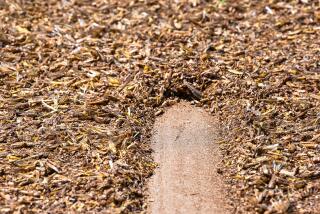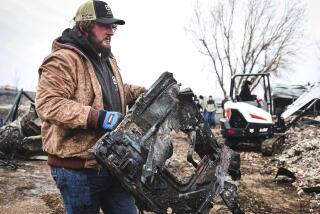Drought Squeezing Texas Ranchers
- Share via
ALPINE, Texas — When the weather cooperates with a little water, Tom Beard’s ranch is as good as any cattle country in Texas, its fertile range land readily capable of sustaining a foraging herd.
“If it doesn’t rain, it’s a lot of rocks and dirt,” Beard said.
Lately, to his dismay, he has seen much more of the latter.
A far-reaching drought has been gradually drying up many Texas ranches, forcing cattlemen to buy expensive feed or scour their depleted lands for patches of vegetation to nourish their livestock.
Failing that, they have been forced to sell their cattle, sometimes even their most valued breeding stock. In these days of depressed beef prices, that means few ranchers are likely to turn a profit.
Beard estimates his breeding stock is down about 30% and his ranch north of Alpine is operating with only about half the normal number of employees. He doesn’t expect to make any money this year.
“You might say we haven’t seen the worst yet,” Beard added. “It’s a continually deteriorating situation.”
*
The $6-billion Texas cattle industry is grappling with three big problems: the drought, low beef prices and high feed costs.
Individually, cattlemen say, the problems can be surmounted, with some difficulty. Combined, they pose a particularly nasty situation that has now reached crisis proportions statewide, says Charles Carter, executive director of the Cattlemen’s Assn. of Texas.
“We have started to see that a lot of our producers who have just been trying to hang on and hang on and hang on, all of sudden they can’t hang on anymore,” Carter said.
Far West Texas has been in a drought for at least three years, and normally grassy plains and hills have been reduced to red rock and bare earth. Other areas have gone dry only in the last few months.
At first, longtime ranchers compared the situation to a five-year drought during the 1950s. More recently, they’ve been calling up images of the Dust Bowl of the 1930s.
“We weren’t making very much money to start with, but it’s gotten very serious now,” said Beau White, a rancher near Valentine. “It’s going to thin us out.”
Normally ranchers would be able to buy feed to sustain their herds, or even lease land for forage. The cost of feed has soared, however, and too many pastures are depleted.
The depressed beef prices, blamed largely on a glut of cattle on the market, have made it difficult for ranchers to justify the cost of supplemental feeding anyway.
“You can’t afford to put $80 (worth of hay) into a cow that’s worth $250 if you take it to auction,” said Jim Selman, a cattle producer in Gonzalez and president of the cattlemen’s association.
So far the only alternatives have been either to find some other way to feed the livestock--South Texas ranchers have been burning the spines off prickly pears so the cattle can eat them--or to sell it altogether. Some people have sold their entire operations.
Yet liquidation creates its own problems. Besides perpetuating the market glut caused in part by an overabundance of beef from northern Mexico, which is suffering its own drought, mass sales can also mean financial losses in the future.
“Any time you have to sell your breeding stock at 50% to 60% of what it’s worth, then it hurts,” Carter said. “You feel it down the road when it does rain and we have better conditions.
“Prices probably aren’t going to be low when they get ready to restock,” he said. “Selling low and buying high does not create a profit picture.”
Unfortunately for cattle producers, not many options are apparent. The general consensus is that sustained rains throughout the region are the only thing likely to turn the situation around. There is no good way to know when that might happen, however.
Some estimates place good rainfall in some of the afflicted areas later this year, but there are gloomier assessments for others.
*
Charlie Hart, a range specialist with the Texas A&M; Extension Service in Fort Stockton, said he has seen one estimate that foresees a drought extending into 1999.
“I’m scared to death that the worst is yet to be seen,” he said.
Hart also points out that there’s little to be gained by forecasting an early end.
“No one dares to predict that the drought is going to break because if it doesn’t happen, people get mad at them,” he said. “People don’t get quite so mad at you if you predict the drought is going to go on and it breaks.”
More to Read
Sign up for Essential California
The most important California stories and recommendations in your inbox every morning.
You may occasionally receive promotional content from the Los Angeles Times.













